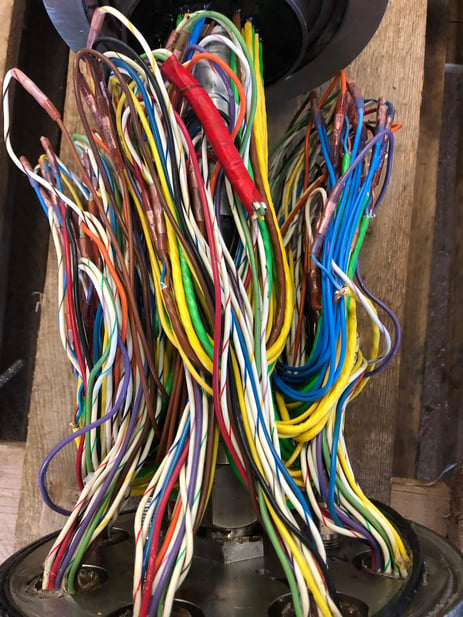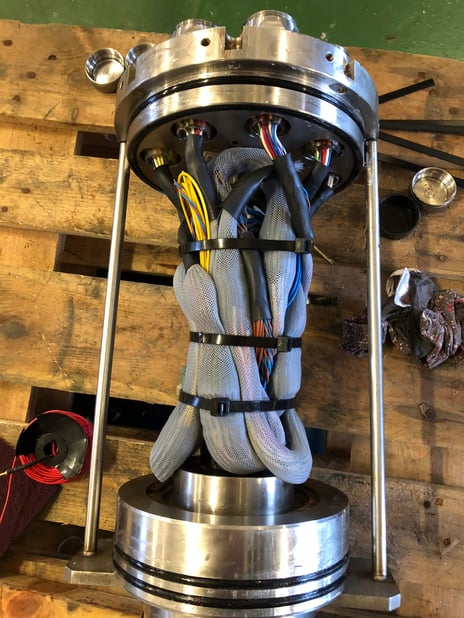Downtime of a subsea project can be very expensive, depending on how long the operation’s standstill takes. Field Service’s main goal is to help clients prevent downtime or solve it as quickly as possible. This saves a lot of time - and money.
When fixing damages, our field service engineers always try to think of the most sustainable and user-friendly solution possible. This solution should make downtime as short as possible, but also be environment-friendly and cheap. An interesting option here is re-terminating.
What is re-terminating?
A damaged termination can cause a lot of trouble, as terminations consist of several specialized electrical, optical and mechanical components. These are usually protected from damage and the corroding effects of seawater with a large, air-tight stainless steel bellhouse. But what if the outer skin of a cable becomes damaged?
A damaged outer skin will allow seawater to penetrate the waterproof outer jacket and begin migrating through the cable. The water may seep into the cable’s armor, which is designed to bear the full load of towing several tons of heavy cables and equipment. Eventually, the steel armor wires may corrode in the salt water, causing it to lose strength and endangering the ship’s mission.
A hazardous case in which re-terminating might come to the rescue. The ease of re-termination and the amount of metal that can be reused depends in part on the component design. 
A re-termination is basically installing a new sea end (and sometimes deck end) by cutting out the damage or failure in the cable and make a whole new strength element and connections.
“At DeRegt, all of our cables are designed from the start to allow their stainless-steel components to be reused as much as possible,” said Mario Boot, head of the Field Service Division. “When we re-terminate, we try to recover as much of the steel work as possible and use it for the re-termination.” Moulded parts like seal plates are taken home and refurbished. When inspected and found within spec, these can be used again on other cables.
How to perform a re-termination in 4 steps
1. Getting on board and finding the source of the problemWhen a cable needs repairing, the first step is to call in DeRegt’s Field Service. Our Field Service Engineer will get on board to analyze the problem. It all starts with finding the source of the leak.
2. Disassembling: removing the damaged portion and checking for re-usable parts
Once the location is pinpointed, the engineer begins the process of removing the damaged portion of the cable and relocating the termination to a good section. From the cut off part, the termination is removed and cleaned. All parts are inspected and made sure they are suitable for re-use.
3. Re-building according to the specifications
When suitable for re-use, the parts are installed on the cable according to the specification. At the new location the measurements are taken for stripping the cable. When all components are at the correct length, the fitting is installed with a swaging device. The armor body is installed over the clean steel wiring and a gripper is installed. The gripper is used to keep the outer jacket in place when towed on the cable.
With the armor body in place the strength element is filled with wire lock securing the complete strength element. Creating a conical shape will secure the strength. When this is done the cable is basically watertight installed into the steel work. All connections can now be made.
4. Quality Check / FAT On-board
When all connections are made the cable is tested on all the components. This test is called the FAT test and this is handed over to the client. With the connections in spec the bellhouse will be closed and the cable is ready for production again.
“In the past, part of the seal plate and several other metal parts inside the bellhouse would always be thrown away,” Boot said. “But if you take a little effort up front, you can reuse all those parts.”
How refurbishing in DeRegt Field Service works
Boot has years of experience traveling to clients’ vessels to perform re-terminations, and he makes a point of recycling any parts that can be refurbished.
“For example, to replace the part filled with a chemical potting compound, I will bring a new one or a refurbished one with me to the job and take the used one home and clean it chemically – so basically I’m just changing parts between the cables,” Boot said.

“And as long as I can reuse the parts, clients won’t be charged for them,” he said.
However, there are circumstances where parts can no longer be reused. “Any surface rust can be cleaned from the part so that’s not a problem, but mechanical damage from corrosion is permanent,” Boot said.
In addition to reusable metal parts, several consumables are required for each re-termination, including crimps, heat shrinks, braiding, O-rings, and a chemical potting compound for the seal. These can’t be reused and must be purchased new.
In part 2, you can read more about the benefits of reterminating
DeRegt’s expert and experienced undersea cable Field Services Division is on call 24-7 to help reduce or eliminate downtime for your subsea cables. We are eager to recycle our clients’ used cable and termination parts, and the field service department cleans and checks each piece for quality, to make sure they can safely be reused.
Read our case study on a strategic partnership between DeRegt and PGS that has helped maintain its marine cable seismic data acquisition cables for maximum production while at sea.



